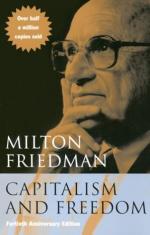|
This section contains 763 words (approx. 2 pages at 400 words per page) |

|
Liberalism
For Friedman, liberalism is not the philosophy of social freedom, the mixed economy (the combination of capitalism and socialism) and expansive social welfare programs. Instead, it is an older creed of those who first called themselves liberals in the 19th century, of what is today called "classical liberalism." Classical liberalism is akin to modern day libertarianism, though it is not as centrally focused on equating justice with respect for private property rights.
Instead, it emphasized the ending of state involvement in religion, representative government, free enterprise, free trade, the abolition of slavery, the social advancement of women and the traditional liberal freedoms of speech, religion and press.
Liberals strongly defended limiting government, social creativity, individualism, constitutionalism and the rule of law. They ardently argued for the decentralization of power and the inherent limitations on the ability of men to fundamentally reform society. They were also cosmopolitan in emphasis...
|
This section contains 763 words (approx. 2 pages at 400 words per page) |

|




